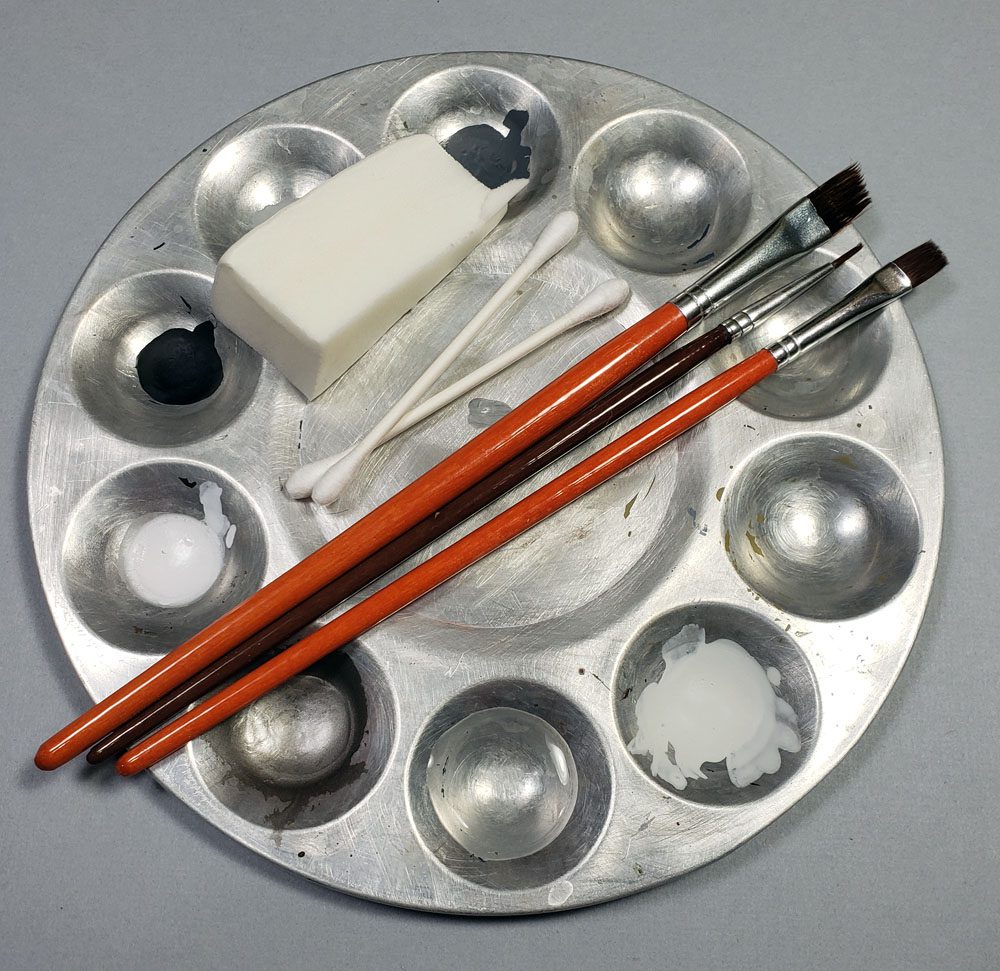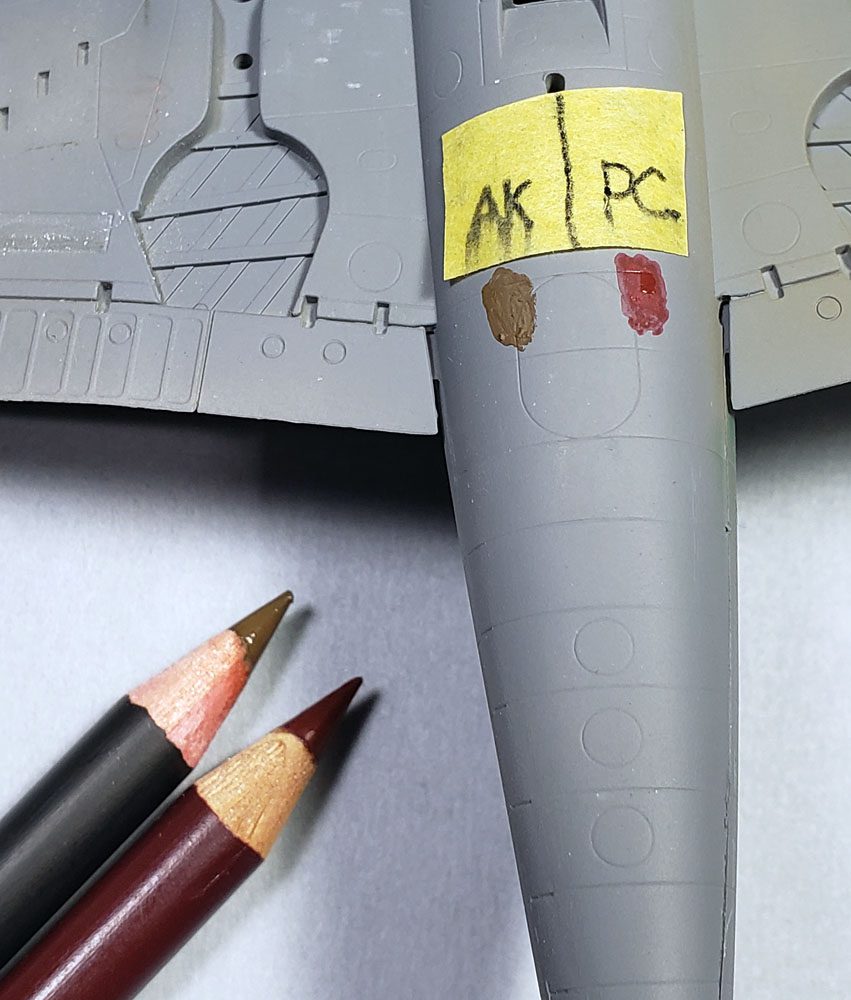While most of my writing regarding scale modeling is about building, techniques, and so forth, it’s also allowed me to spend a lot of time observing the culture of scale modelers. While there are some nuances based on genre and generation, for the most part there are far more similarities than differences.
One of the aspects that seems to be inherent to modeling life is an almost insatiable appetite to try new products. Whether something sounds logical, or totally implausible, we all seem to want to give it a shot. There’s always that quest for the new, one, amazingly great thing that will make our models 7% better. (Or whatever number you prefer… 😉 )
So anytime a new product comes out, I am as fascinated by the product as I am the reaction. It’s fun to see how the news spreads, and what assumptions are made – often without anything other than the manufacturer’s initial photo.
Get To The Point
Such was the case when AK Interactive announced their Weathering Pencils. As soon as I saw the news on social media, the assessments began rolling in. Comments ranged from “meh, big deal“, to “it’s just rebranded Prismacolor“, to “this is the best thing ever!“
Of course, none of those folks that I saw commenting had ever seen the actual pencil, let alone used one. I get that people generally have an immediate reaction to anything – I know I do. Mine was something along the lines of “How similar are they to the Prismacolor pencils I use, and what is the cost difference?” But it did make me chuckle with how much was said with an almost baseless air of authority.
Ever curious, I decided to find out the answers to those questions.
The Truth Is Out there
I checked the AK website, and sure enough, they had quite a large range of colors, both in singles and boxed sets. Not wanting to pay shipping from Spain for what essentially amounted to colored pencils, I checked my favorite local hobby shop, Hayes Hobby House in Fayetteville, North Carolina, to see if they could get them. They could, but the supplier was already out of stock.
Deciding that my tests could wait, I went ahead and placed my order, assured they would arrive in just a couple of weeks. Given that was about the same time it would take to get a shipment from Spain, it worked out – plus the local economy would benefit from my $20 outlay. 😉
In the meantime, I watched a video that AK Interactive had posted about the pencils. Aside from the horrible autotranslated voiceover (c’mon… there HAS to be someone in Spain who can do a real voice over?), the video was promising.
It showed a variety of uses, both dry and wet, that ranged from chips and streaks to rust and mud effects. In many ways, they appeared to work a bit like oils.
Rubber Meets The Road
The pencils arrived a bit sooner than expected, so I happily dropped by the shop. The initial visual inspection showed them to be… well, colored pencils basically. Not that I was expecting something different, I suppose.
The pencils come in a wide assortment that are labeled for easy identification by modelers. Rather than the artistic color names often used for art store products, AK logically chose names such as Rubber, Smoke, Light Rust, Chipping Color, Red Primer, and so forth. I don’t know if they are matched to the existing AK paint range.
I decided to test them out against a few Prismacolor pencils I already had on hand. My use of those typically amounted to scratches and chips, and occassional dots of color on instrument panels, etc.
Using the Ak Interactive video as a guide, I narrowed down the variety of applications shown there to just a few basic tests.
The Actors
While I did not have exact color matches for each range, my goal was not to compare color, but rather performance. I grabbed a handful of pencils, a pencil sharpener, some brushes a palette with water, and a 1/72 F6F-3 Hellcat that has become my “guinea pig”.
Here are the victims for the test.
Chipping and Scratches
The first test was pretty simple – chipping and scratches. I’ve used a Prismacolor silver pencil for years to add abuse to models. They worked very well, and generally do a good job.
For this test I could use almost identical colors. The AK pencil was Aluminum, and Prismacolor was Silver. I followed the procedure I normally do, both coloring in around panel lines, and adding “dots” of color to make a chipped area. The overall performance of each product was about the same. Each deposited color in place, leaving a few grains of the pencil material here and there.
The Prismacolor pencil was a bit brighter, but I think that has more to do with color difference than opacity. I felt the Prismacolor pencil had a slight edge in terms of how the initial application “gripped” the surface. It seemed to deposit just a slight bit more color than the AK contender. But it was a minimal difference – I could happily use the AK pencil in place of the Prismacolor one.
Brushed Metal
One of the techniques the AK video showed was a method to create a metallic, brushed effect. The test for this was simple. I colored in a small area with both pencils, and then using both a cotton bud and a small makeup sponge, I rubbed the colored area. To try and keep it same/same, I applied the same number of pencil strokes for each product, and the same number of “rubs”.
The result for both was… less than stellar. The AK version did seem to buff a bit better, but not to the point that I felt it was actually useful. The Prismacolor Silver didn’t do much more than smear and tint the surface around it.
I don’t know if my application was wrong, or that the technique is just not impressive. Based on this brief test, I wasn’t sold on either. To be fair, doing this test over green was not optimal. It may have worked just fine on a gun barrel or gear strut, so it certainly deserves further testing.
Streaking and Staining (wet and dry)
One of the techniques shown in the video was using the pencils for streaks and stains. Varying types were show – grime, rust, rain, etc. I decided that while the color and placement of the streaks would determine the type, the overall pencil behaviour could be tested by simply applying a line of color, and then streaking and blending it.
I used AK Rainmarks, and Prismacolor Cool Gray. While not exact matches, I felt that visually they could demonstrate the performance equally well.
I started by applying some lines of color, making sure to apply the same pressure on each stroke. Next, following the robot voice instructions in the video, I used a soft flat brush to attempt to streak them dry.
For the most part, the Prismacolor streaks just looked at me and said “Is that the best ya got?” They didn’t budge. The AK streak did blend a little… and by a little I mean not really enough to be useful. And that was only after 40 strokes of the flat brush.
Switching to a different flat brush, this one lightly damped with water, gave a different result. While Prismacolor sat defiant with arms folded and would not move, the AK pencil streaked nicely. In just a few strokes, it had blended almost completely away. It did however leave just a slight streak – much like a dot filter effect. I thought that was a notable – and useful – result. Streaking like oils, without the long drying time.
Wet pencil application
One of the more interesting applications shown in the AK video was dipping the pencil in water, and then applying it to the surface of the model. The result appeared to look almost like thinned oils, and could be worked into a variety of dirt and grime effects.
I decided to flip the model over, and apply some high contrast colors on the gray primer. The intent, of course, is not to show a plausible color, but rather to examine the performance. The AK Sepia and Prismacolor Tuscan Red were selected for this test.
Dipping each in water, I dabbed the pencil to the underside. Each deposited a very opaque, rich dollop of color – both looking very similar to artists oils at this point.
Each was then given a basic “streak” with the damp flat brush. While both did streak, the result was not terribly useful. I did note that the AK color dried with a different tone.
These streaks were then tested with a dry brush, each being subjected to 25 strokes. Both sat defiant and motionless.
I switched back to the damp flat brush. This time, each yielded further steaks. The Prismacolor streaking was less useful, as it tended to get a bit grainy in some areas, and simply disappeared in others. The AK pencil, however, gave a fairly nice result. It was promising enough that I feel a bit if practice and refinement can make this worth doing “in production”.
Conclusions
While I’d only label this as an initial test, I came away liking the AK Interactive Weathering Pencils, though with a few caveats.
They AK Weathering Pencils are definitely more workable than the Prismacolor pencils, allowing for much better results from water application. Though the technique I used needs a bit of refinement, I feel that they are superior in this way. Streaking dry did not produce workable results from either in this test.
For chipping, edge highlighting, panel coloring, etc., I think they are equally capable. They have about the same opacity (though Prismacolor has just a tiny bit more in a single application), and leave roughly the same result when applied directly. But each would serve equally well in that regard.
I’ll say the jury is still out on the metal polishing test. It may work better on surfaces that have some relief, rather than the flat area I tested this one. Still, with the method used for this, both yielded similar results, with just a slight tip of the cap to AK.
The final comparison is price. At the local shop, I paid US$2.29 for each AK pencil. Online pricing was found to be a little less – $1.89. However, shipping would negate that savings unless purchased in quantity.
Pricing the Prismacolor product locally showed roughly the same prices – $2.29 at one art store, and $2.49 at another. Online prices varied much more, ranging from $1.20 to $3.00. However, with shipping, even the best price gets right back to AK’s price point.
Overall, I’d give the AK Interactive Weathering Pencils a solid recommendation. They performed roughly the same as the Prismacolor brand in all tests. In terms of workability, they are far superior to Prismacolor. The fact that they use modeler friendly names is helpful. And the price point is very competitive.
Neither are a viable replacement for oils, enamels, and even acrylic products. But pencils in general do offer ease of use and precision of application, and absolutely no specialized tools or knowledge to apply. I’ve always found them to be a useful addition to my toolbox of products.
Give them a shot and let me know what you think!



















Leave a Reply